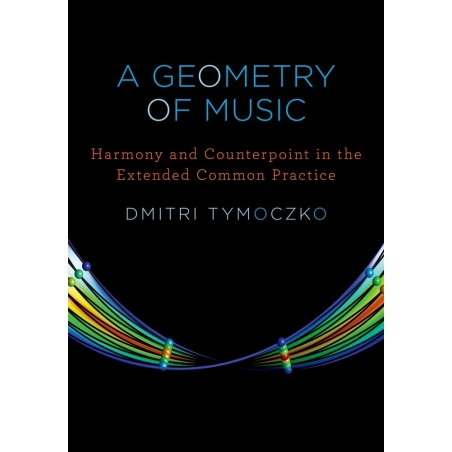In this groundbreaking book, Tymoczko uses contemporary geometry to provide a new framework for thinking about music, one that emphasizes the commonalities among styles from Medieval polyphony to contemporary jazz.
CONTENTS
PREFACE
PART I. Theory
1 Five Components of Tonality
1.1 The five features.
1.2. Perception and the five features.
1.3 Four Claims.
A. Harmony and counterpoint constrain each other.
B. Scale, macroharmony, and centricity are independent.
C. Modulation involves voice leading.
D. Music can be understood geometrically.
1.4 Music, magic, and language.
1.5 Outline of the book, and a suggestion for impatient readers.
2. Harmony and Voice Leading
2.1 Linear pitch space.
2.2 Circular pitch-class space.
2.3 Transposition and inversion as distance-preserving functions.
2.4 Musical objects.
2.5 Voice leadings and chord progressions.
2.6 Comparing voice leadings.
2.7 Voice-leading size.
2.8 Near identity.
2.9 Harmony and counterpoint revisited.
2.10 Acoustic consonance and near-evenness
3. The Geometry of Chords
3.1 Ordered pitch space.
3.2 The Parable of the Ant.
3.3 Two-note chord space.
3.4 Chord progressions and voice leadings in two-note chord space.
3.5 Geometry in analysis.
3.6 Harmonic consistency and efficient voice leading.
3.7 Pure parallel and pure contrary motion.
3.8 Three-dimensional chord space.
3.9 Higher-dimensional chord spaces.
3.10 Voice leading lattices.
3.11 Triads are from Mars, seventh chords are from Venus.
3.12 Two musical geometries.
3.13 Study guide.
4. Scales
4.1 A scale is a ruler.
4.2 Scale degrees, scalar transposition, scalar inversion.
4.3 Evenness and scalar transposition.
4.4 Constructing common scales.
4.5 Modulation and voice leading.
4.6 Voice leading between common scales .
4.7 Two examples.
4.8 Scalar and interscalar transposition.
4.9 Interscalar transposition and voice leading.
4.10 Combining interscalar and chromatic transpositions.
5. Macroharmony and Centricity
5.1 Macroharmony.
5.2 Small-gap macroharmony.
5.3 Pitch-class circulation.
5.4 Modulating the rate of pitch-class circulation.
5.5 Macroharmonic consistency.
5.6 Centricity.
5.7 Where does centricity come from?
5.8 Beyond tonal and atonal.
PART II. History and Analysis
6. The Extended Common Practice
6.1 Disclaimers.
6.2 Two-voice medieval counterpoint.
6.3 Triads and the Renaissance.
6.4 Functional harmony.
6.5 Schumann's Chopin.
6.6 Chromaticism.
6.7 Twentieth-century scalar music.
6.8 The extended common practice.
7. Functional Harmony
7.1 The thirds-based grammar of elementary tonal harmony.
7.2 Voice leading in functional harmony.
7.3 Sequences.
7.4 Modulation and key distance.
7.5 The two lattices.
7.6 A challenge from Schenker.
8. Chromaticism
8.1 Decorative chromaticism.
8.2 Generalized augmented sixths.
8.3 Brahms and Schoenberg.
8.4 Schubert and the major-third system.
8.5 Chopin's tesseract.
8.6 The Tristan Prelude.
8.7 Alternative approaches.
8.8 Conclusion
9. Scales in Twentieth-Century Music
9.1 Three scalar techniques.
9.2 Chord-first composition.
A. Grieg's Drommesyn, (Vision), Op. 62 no. 5 (1895).
B. Debussy's Fetes (1899).
C. Michael Nyman's The Mood That Passes Through You (1993).
9.3 Scale-first composition.
A. Debussy's Des pas sur la neige (1910).
B. Janacek's On an Overgrown Path, Series II, no. 1 (1908).
C. Shostakovich's Fs minor Prelude and Fugue, Op. 87 (1950).
D. Reich's New York Counterpoint (1985).
E. Reich's The Desert Music, movement 1 (1984).
F. The Who's Can't Explain (1965) and Bob Seger's Turn the Page (1973).
9.4 The Subset Technique.
A. Grieg's Klokkeklang, (Bell Ringing), Op. 54 no. 6 (1891).
B. Petit Airs, from Stravinsky's Histoire du Soldat (1918).
C. Reich's City Life (1995).
D. Stravinsky's Dance of the Adolescents (1913).
E. The Miles Davis Group's Freedom Jazz Dance (1966).
9.5 Conclusion.
10. Jazz.
10.1 Basic jazz voicings.
10.2 From thirds to fourths.
10.3 Tritone substitution.
10.4 Altered chords and scales.
10.5 Bass and upper-voice tritone substitutions.
10.6 Polytonality, sidestepping, and playing out.
10.7 Bill Evans's Oleo.
10.8 Jazz as modernist synthesis.
CONCLUSION
APPENDIX A. Measuring voice-leading size
APPENDIX B. Chord geometry: a technical look.
APPENDIX C. Discrete voice leading lattices.
APPENDIX D. The interscalar interval matrix.
APPENDIX E. Scale, macroharmony, and Lerdahl's basic space.
APPENDIX F. Some study questions, problems, and activities.
BIBLIOGRAPHY
INDEX
| Series | Oxford Studies in Music Theory |
|---|


